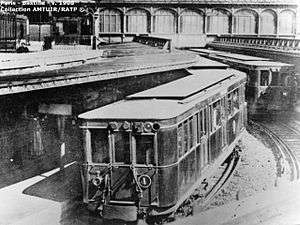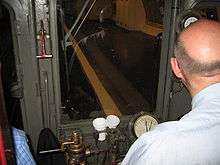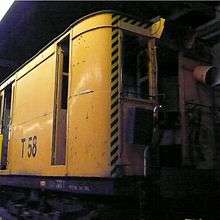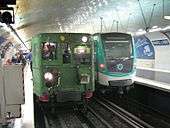Sprague-Thomson

Sprague-Thomson is the name of the first rolling stock on the Paris Métro made completely of metal.
History
Research before 1908



_-_Circulation_de_la_rame_Sprague-Thomson_historique_sur_la_ligne_12_-_Station_Pigalle.ogv.jpg)

In light of the Paris Métro train fire of 1903, the Compagnie du chemin de fer métropolitain de Paris (CMP) searched for a rolling stock that was both durable and safe. The Thomson Multiple stock was the most adopted at the time, but was complex. At the same time, the American Sprague stock did not fit the requirements.
Two motors
The Sprague-Thomson was conceived in 1908 by the synthesis of already-existing systems. Beginning in 1907, the CMP was constructing metallic stock. The motrices 500 (motor cars) formed the first series of Sprague-Thomson, which was referred to familiarly as simply "Sprague". The cars were constructed entirely of metal and had two motors. One train set consisted of five cars and three motor cars, and contained a large compartment of electrical components, referred to as a grande loge. After World War I, the motor cars were improved so that the electrical components did not take up so much space and thus were called petites loges.
Certain grande loge motor cars were regrouped into sets of two in order to form work trains with two compartments. These were first painted gray, but later repainted yellow. The arrival of the TMA material in the 1980s and the TME material in the 2000s allowed for many of these motor cars to be retired. A project to convert some MF 67 cars running between depots is in progress to replace the Sprague trains that are currently dedicated to this task. The last Sprague tractors are planned to be replaced by 2010. The T.74, T.91 and T.94 models are preserved by the ADEMAS association and the T.95 model is preserved by the RATP.
"Nord-Sud" motorcars
The Compagnie du Nord-Sud began construction in 1910 of a new type of Sprague, with four engines on the two motorcars per train instead of three motorcars. They are painted gray and blue, unlike the dark green color of those of the CMP.
Motorcars with four motors
Little by little the cars have been elongated, from their initial length of 12,600 mm (41 ft 4 in) to 14,200 mm (46 ft 7 in). Motorcars with four engines were first used in 1927 and are all 14,200 mm (46 ft 7 in) long. The color (dark green, light green, and bluish gray) has varied over time, as well as the number of doors (from three to four). The first class cars are red on the CMP network, and yellow on the Nord-Sud. Some cars are colored half green and half red. The classic electric multiple unit trainset contains two motorcars with four engines each, powering three cars with the middle one being first class. Motorcars with four engines began use in 1936, some being older models reconstructed but practically identical to the new ones.
Decline
In 1956, the installation of bogies with tires on line 11 resulted in the retirement of many Sprague trains, many of which were turned into maintenance trains. The same replacement occurred on line 1 in 1963 and line 4 in 1967.
End of the model
The introduction of the MF 67 rolling stock on line 3 in 1968 accelerated the replacement of the Sprague. The MF 67 stock was first introduced on line 7 and then on many other lines. In 1975, lines Paris Métro Line 2, 3bis, 5, 7bis and 12 were serviced entirely by Sprague trains and lines 8, 9, and 10 were serviced partially by those trains. The last two-engine motorcars were removed from 2 in 1976. The Nord-Sud had been entirely eliminated by 1972.
The arrival of the MF 77 accelerated the removal of Sprague trains which by that time were found only on line 9. By 1982 they had virtually been entirely retired, however the flooding of the station Église de Pantin put a number of MF 67 trains out of service. As a result, line 5 borrowed stock from line 9, and the Sprague was active again. The last four Sprague trains of line 9 stopped service on April 16, 1983 after 75 years of service. The last trains in service were yellow, however it is possible that certain trains from 1908-1910 had circulated 65 years.
Legacy
The RATP has conserved three Sprague trains, however only one is usable by passengers. From time to time it is exhibited on certain lines and by organizations such as (ADEMAS, COPEF). A number of cars are in museums and those serving as maintenance trains are approaching the age of 100.
Three cars (two second class with their engine and one first class) were classified as historical monuments on December 18, 1998. Another car, a second class multiple unit is preserved at the Vaugirard depot.
